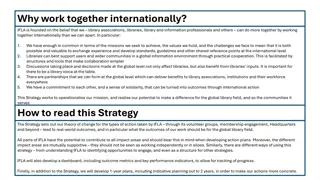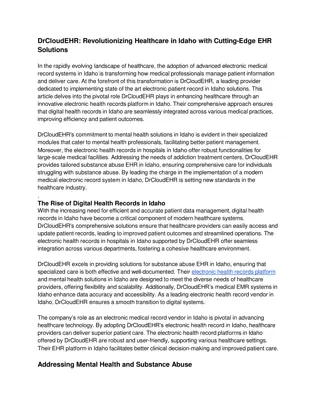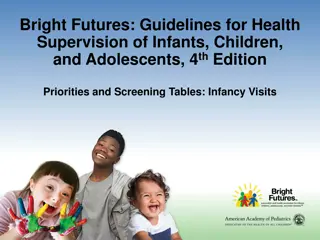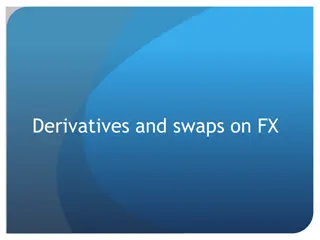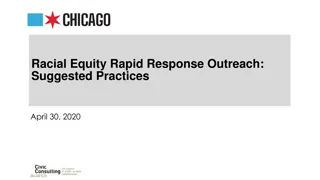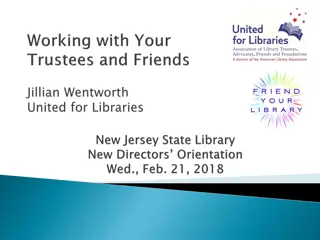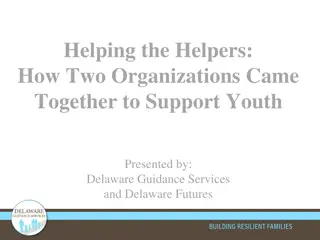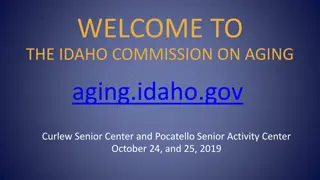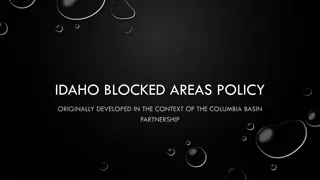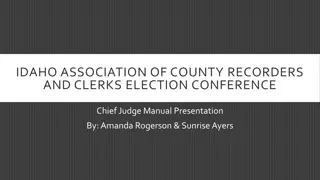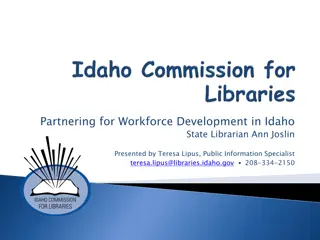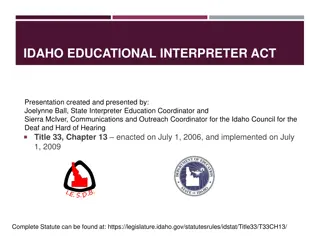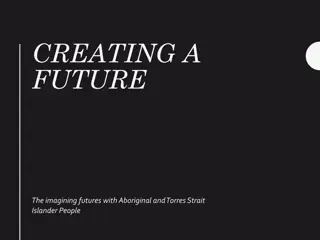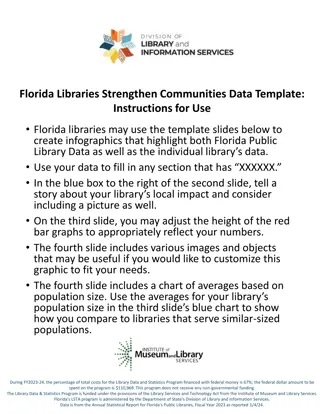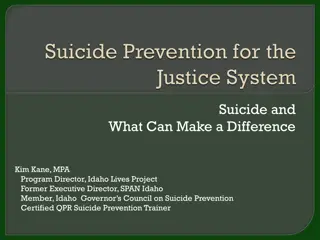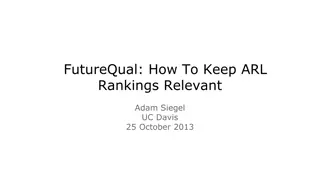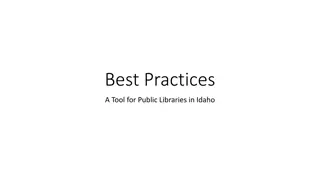Idaho Commission for Libraries - Bright Futures Outreach Programs Summary
The Idaho Commission for Libraries conducted the Bright Futures Outreach Programs in 2015, focusing on summer reading coordinators, school visits, reaching underserved children, and maintaining reading achievement skills over the summer. The program aimed to encourage children to read independently, with a minimum target of 10 books or 10 hours during their summer break. Evaluation of the program was highlighted as crucial for its success.
Download Presentation

Please find below an Image/Link to download the presentation.
The content on the website is provided AS IS for your information and personal use only. It may not be sold, licensed, or shared on other websites without obtaining consent from the author. Download presentation by click this link. If you encounter any issues during the download, it is possible that the publisher has removed the file from their server.
E N D
Presentation Transcript
BRIGHT FUTURES Outreach Programs 2015 Idaho Commission for Libraries
ICFLSUMMER READING COORDINATORS: Staci Shaw Stephanie Bailey-White Erica Compton
BRIGHT FUTURES OUTREACH PROGRAMS: School Visits Reaching Underserved Children School Partnerships
Summer Learning Loss Outcomes- Based Big Picture National focus Summer Reading Programs Best practices Use of federal dollars Evaluation and research State needs Data Collection Evaluation Impact
Outcome for ICfL Summer Reading: Children will maintain reading achievement skills over the summer with support from Idaho libraries.
Idaho Summer Reading Participation 2001-2013 120,000 Participation in Summer Reading 95,364 100,000 83,821 80,000 69,47271,443 Children Participating Need for consistent baseline data 63,300 60,000 45,850 44,600 36,62040,700 40,000 27,610 25,30224,458 21,128 20,000 0 1 2 3 4 5 6 7 8 9 10 11 12 13 Program Years 2001-2013 (Bright Futures Implemented 2004)
Desired Output: Children will read a minimum of 10 hours or read a minimum of 10 books during their summer break.* *Read= reading independently and/or being read to (read alouds, audiobooks, online books)
Desired Output: 10 books/10 hours Not mandatory! Libraries that agree to track this information will be given priority in Bright Futures applications Many libraries already tracking Adaptable Summer reading coordinators available to answer questions
EVALUATION If you do not formally evaluate your summer reading program others will do so for you.
Formal Evaluation: All libraries wishing to participate in any Bright Futures program must formally evaluate its summer reading program.
Formal Evaluation Questions are planned and deliberate Based on what the library needs to know about its SRP Data can be compiled and evaluated Surveys, focus groups, comment cards in-house and at outreach, partnership with schools to collect test data, etc. Formal evaluation is NOT: Verbal feedback from participants or parents Conversations with participants or parents Comments overheard during programs, etc.
Chart of Applicants Chart of BF Applicants (to date)
School Visits Objectives Through face-to-face contact with elementary school children, public library staff communicate the importance of maintaining a consistent reading routine over the summer months. inform students, teachers, and parents about how to participate in the library s summer reading program.
School Visits Requirements Face to face contact with students, either by visiting the school or hosting school field trips to the library, in which library communicates why they must continue reading over the summer. Students take home branded educational materials and information about how to participate in library s summer reading program. Only elementary schools (grades K-6) are eligible. Track number of schools and children for summer reading report. Public library must formally evaluate the effectiveness of its summer reading program * Priority will be given to libraries that agree to track the number of children who read at least 10 hours during the course of the SRP.
Face-to-face communication with parents: http://libraries.idaho.gov/page/summer-reading-resources
Application: due by March 20 List each school and number of children in target grades of each school
Data Tracking Summer Reading Report due: September 15
REACHING UNDERSERVED CHILDREN
Reaching Underserved Children Objectives: Public library staff collaborate with community partners to engage hard-to-reach students in reading activities that occur out in the community. Public library staff communicate the importance of maintaining a consistent reading routine over the summer months.
RUSC Requirements: Collaborate with community partner Face to face contact with children and families off-site of library grounds, in which library distributes books and communicates importance of reading over the summer. Track sites and attendance Public library must formally evaluate the effectiveness of its summer reading program * Priority will be given to libraries that agree to track the number of children who read at least 10 hours during the course of the SRP.
RUSC Materials Paperback books for age group(s) requested Yard sign to announce visit and/or schedule of visits
Little Libraries (optional component) Weekly program offsite for at least five weeks in a row (park, summer school lunch program, community center, Farmer s Market, etc.). Rotate bin of Read and Return books each week (If needed ICfL can supply bin, starter collection, and Read and Return stickers). Track number of books distributed (generally one per child) Survey children and parents during last two weeks of your program (ICfL provides survey). Return surveys to ICfL and submit statistics in Summer Reading Report, due September 15. Optional but highly encouraged! Weekly activities: Summer Reading Outreach Guidebook
Application: due by March 20 Community Partner Sites, Dates Number of children Age range Little Libraries: Site, Frequency
Data Tracking Summer Reading Report due September 15
SCHOOL PARTNERSHIPS
Qualifications: Publicly-funded public libraries may apply. Public library must provide regularly scheduled summer programs for the targeted school-age students during the application year. If your library is planning construction or remodeling this summer, and regularly scheduled programs will not be held in an alternate location, the library does not qualify for this program. Public libraries must partner with public elementary schools. The following schools do not qualify: private, parochial, preschools, middle/junior high schools, daycares, or homeschool organizations. "Participation" in the library's summer reading program must not be dependent solely on physical attendance at on-site library programs. Libraries that agree to track the number of students who read a minimum of 10 books or 10 hours will be given priority.
School Partnerships Objectives: The public library and elementary school collaborate to minimize summer learning loss. Public library staff, the principal, and the school librarian collaborate to increase student participation in the public library's summer reading program. Parents of elementary school children understand the importance of maintaining a consistent reading routine over the summer months.
Bright Futures: School Partnerships 60 50 40 30 20 10 0 2011 2012 2013 2014 % Schools Achieved Goal % Schools Increased Participation
Components of Successful Programs: Level of involvement of principal or key staff Measureable Goal Personal communication with parents Access to books over summer months Summer monitoring by school Follow-Up
School Partnerships Requirements: 1) Libraries can partner with up to five schools. 2) Meet with each school s principal and librarian in person. Develop a Summer Reading Challenge that involves the whole school or that targets specific grades.
Reading Challenge must include: A goal for the number/percentage of children participating in the public library s summer reading program. 1. A reading output goal for the school (total minutes read, books read, books per child, etc.). 2. A plan for promoting the Challenge to students and parents, as well as teachers and staff. 3. A plan for increasing students access to books and other print materials over the summer. 4. A plan for monitoring student/school progress during the summer. 5. A recognition/celebration event when school resumes in the fall. 6.
Requirements, continued: 3) Track school s student participation in Summer Library Programs. 4) Design and administer an evaluation of the library s summer reading program. 5) Submit participation statistics in Summer Reading Report, due September 15.
School Partnerships Materials Public library and school library each receive in spring: 10 hardcover books 50 paperback books vinyl summer reading banner Partnerships that achieve participation goal receive an additional 5 hardcover books in the fall
Resources Planning worksheets for Reading Challenge Library Toolkit School Toolkit Website
Application: due by March 20 Completed Reading Challenge worksheet for each school
Data Tracking Summer Reading Report due September 15
Contacts Staci Shaw staci.shaw@libraries.Idaho.gov Stephanie Bailey-White Stephanie.bailey- white@libraries.Idaho.gov Erica Compton Erica.Compton@libraries.Idaho.gov
BRIGHT FUTURES BEGIN WITH SUMMER READING!



